People
The Condition of ‘Have-Not-Ness’: Why Performance Artist Pope.L Puts His Body on the Line and Embraces Vulnerability
The artist is the subject of three New York exhibitions this fall.
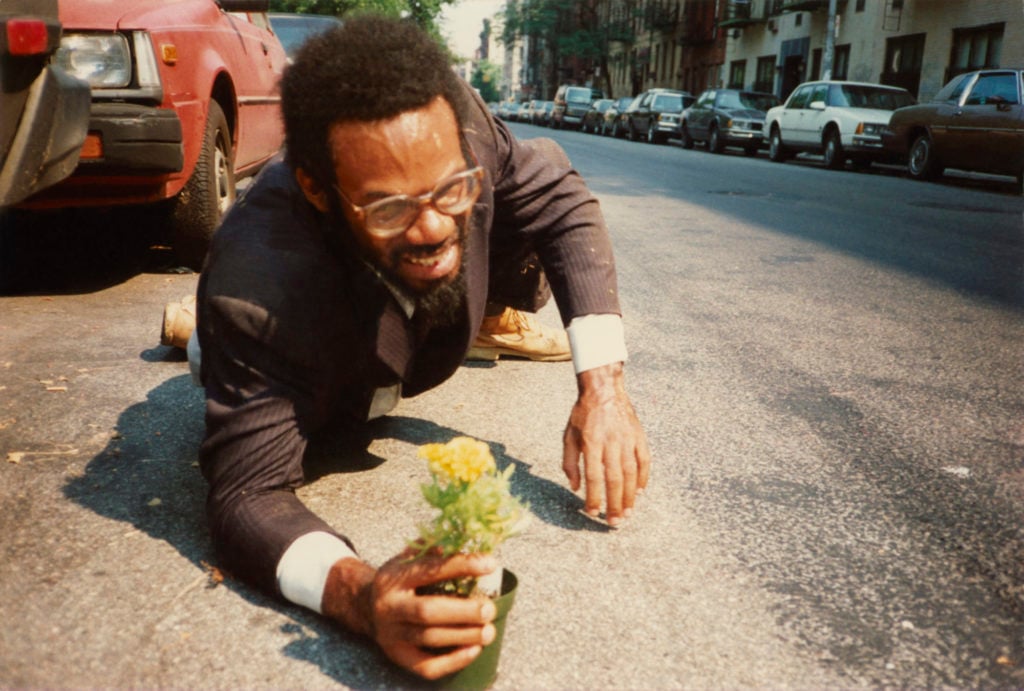
The artist is the subject of three New York exhibitions this fall.

Janelle Zara

In New York, verticality is the definitive modus operandi. Both buildings and people perpetually strive skyward, driven by tenuous dreams of upward mobility. “But, let us imagine,” the American artist Pope.L proposed to fellow artist Martha Wilson in 1996, “a person who has a job, possesses the means to remain vertical, but chooses momentarily to give up that verticality?”
In the sweltering summer of 1978, he stopped supposing. Momentarily suspending his own verticality and the privileges that it implied, he donned a suit, placed his bare palms on the human waste-tinged pavement of Times Square, and began to crawl. It was a performance of “have-not-ness”—a condition of vulnerability in an unforgiving landscape and an even less forgiving social order—that he would repeat alone and in groups more than 30 times over the course of his career.
“In the early days, I did not protect myself very well,” Pope.L tells artnet news. “I crawled without protective padding—without anything, really. Somehow I thought I did not matter.”
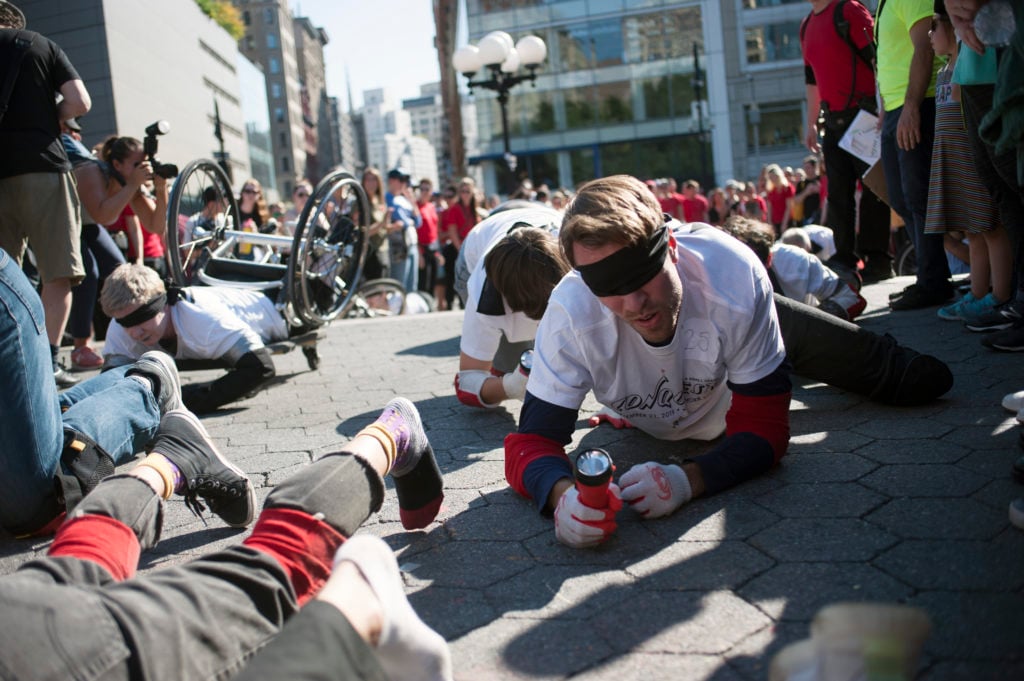
Performers in Pope.L’s Conquest on September 21, 2019, in New York. Photograph by Amy C. Elliott for Public Art Fund and the artist.
This fall, Pope.L is the subject of “Instigation, Aspiration, Perspiration,” a trio of New York exhibitions that each highlight a different aspect of the artist’s expansive, multi-disciplinary practice.
Part one launched this past weekend with Public Art Fund’s “Conquest,” a group crawl of
140 volunteers who willingly surrendered their own verticality, sight, and shoes at the artist’s behest, dragging themselves over a 1.5 mile tract of Manhattan.
Next to come is “Choir,” a new sculptural commission to be unveiled at the Whitney on October 10, and “member: Pope.L, 1978–2001,” a survey of performances through various documentation and ephemera, opening at MoMA on October 21.
“An artist like Pope.L, who is outside the traditional categories of museological presentation, really benefits from this kind of multi-institutional attention,” says Public Art Fund director Nicholas Baume.
Over the four decades of his career, Pope.L has painted, drawn, sculpted, and made installations, but his best-known work has been done largely outside institutional confines. He is a poet, novelist, and playwright, as well as the former lead singer of an ’80s new wave punk band. (Among his influences, he lists Eric Satie, PJ Harvey, Cecil Taylor, and his aunt Jenny.)
He has performed and directed on stage, and for two decades he lectured on theater and rhetoric at Bates College in Lewiston, Maine. Currently he is an associate professor at the University of Chicago’s department of visual arts.
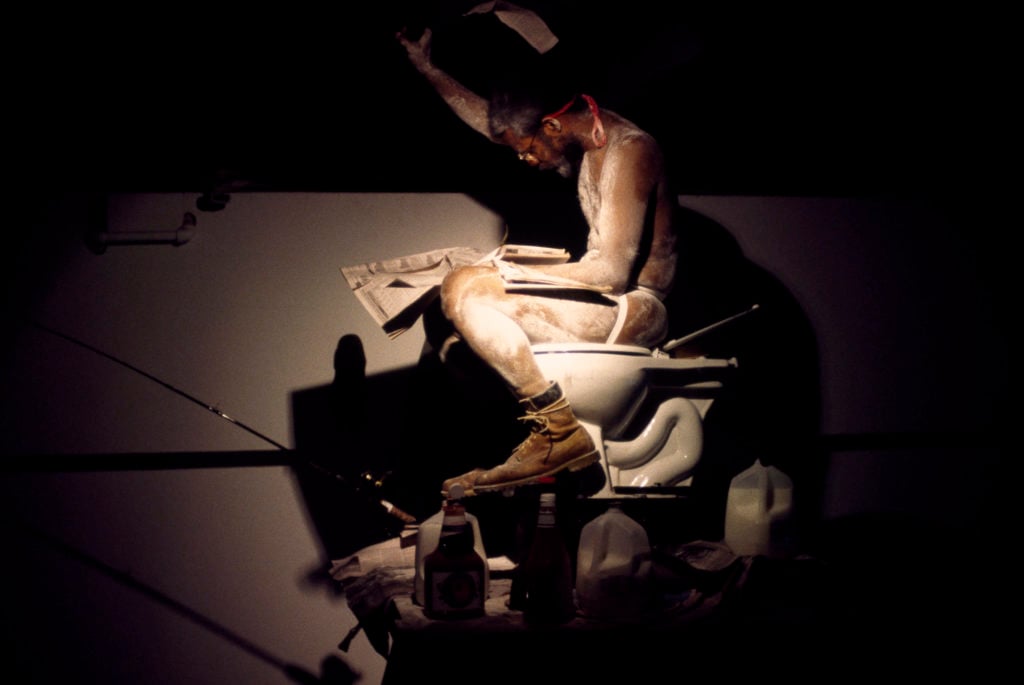
Pope. L. Eating the Wall Street Journal (3rd Version) at the Sculpture Center in New York, in 2000. © Pope. L. Courtesy of the artist and Mitchell–Innes & Nash, New York.
Pope.L was born in Newark, New Jersey, in 1955. He described his childhood as a state of have-not-ness, marred by familial homelessness and addiction. “Have-not-ness,” he has said, “permeates everything I do.”
The artist goes into a willing state of have-not-ness through the self-debasement of his body, which he puts to the test to criticize, in absurd ways, dynamics of power, race, and class.
He has crawled through snow, ingested newsprint, and attempted to sell dollops of warm mayonnaise. He has wrapped himself in sausage links while passing out cash to strangers on the street. In his 1996 work, Sweet Desire a.k.a. Burial Piece, he buried himself upright, packed with dirt up to his shoulders, sweating profusely for eight hours as a glass bowl of vanilla ice cream melted in front of his face.
The presence of a black body in the performance art sphere was revelatory for E.J. Hill, a Los Angeles-based artist. Before 2010, when he came across The Friendliest Black Artist in America, a catalogue of Pope.L’s traveling 2002 exhibition “eRacism,” Hill had only been taught about the performance art of white artists, who had worked “in this purportedly neutral, universal body that everyone has to imagine themselves in,” he says.
In his unsparing assessments of race in America, Pope.L had “added facets that weren’t being talked about in general terms—this conceptual force field, this social construct that exists around the body, the invisible padding that affects the way you move through space.”
The optics of vanilla ice cream and other white props like it—snow, flour, eggs, the white cardboard penis of his 1996 work, Member a.k.a. Schlong Journey—were vehicles with which to talk about race. In the 1991 piece, I Get Paid to Rub Mayo on my Body, the slick coating of mayonnaise on Pope.L’s skin functioned as a high-sheen whiteface that eventually dried to a clear finish and rancid smell.
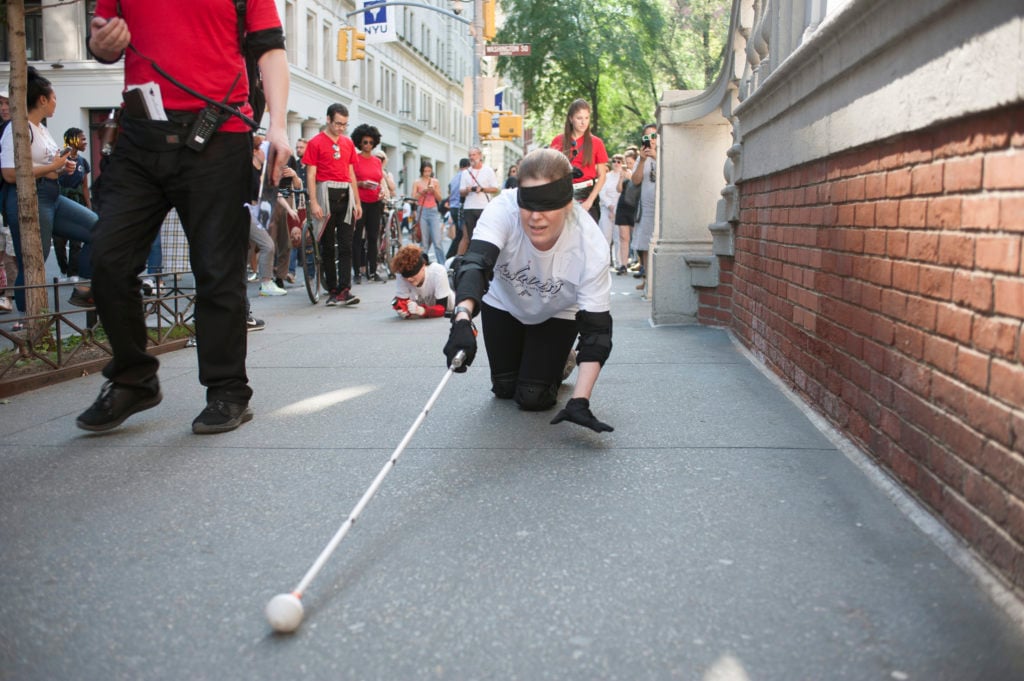
Performers in Pope.L’s Conquest on September 21, 2019, in New York. Photograph by Amy C. Elliott for Public Art Fund and the artist.
“Mayonnaise gave me a quirky material means to deal with issues black people claim they don’t value very much,” he told Wilson. “Whiteness.” At the Whitney, “Choir,” an upside-down fountain evoking Jim Crow-era laws, is accompanied by field recordings of black spirituals. Along with Pope.L’s recent work on the Flint, Michigan, water crisis, the installation points to how access to water in the United States continues to be racialized.
“For decades, he was under the radar, working his ass off and making the sort of challenging, raw, intense, highly critical work that no one was even coming close to making,” says the artist Clifford Owens. In 2011, noting how the art historical record had largely ignored the existence of black performance artists, he solicited new work from 26 black artists for a show at MoMA PS1 titled “Anthology.” Pope.L’s contribution to the exhibition was a simple set of instructions: “Be African-American. Be very African-American.”
“When I first read [that], I said, ‘Man, he’s fucking with me,’” Owens recalls, but he ultimately warmed to it. “It was a brilliant score. What he was really tasking me with was to try and imagine the imaginary construction of what an African-American is.”
For Pope.L, blackness was a state akin to have-not-ness, which he called “a lack worth having.” He embraces lack as a binary state of simultaneous failure and opportunity, he has said. “I am speaking to the dynamic of pain, loss, joy, radicality, and possibility in the experience of being black.”
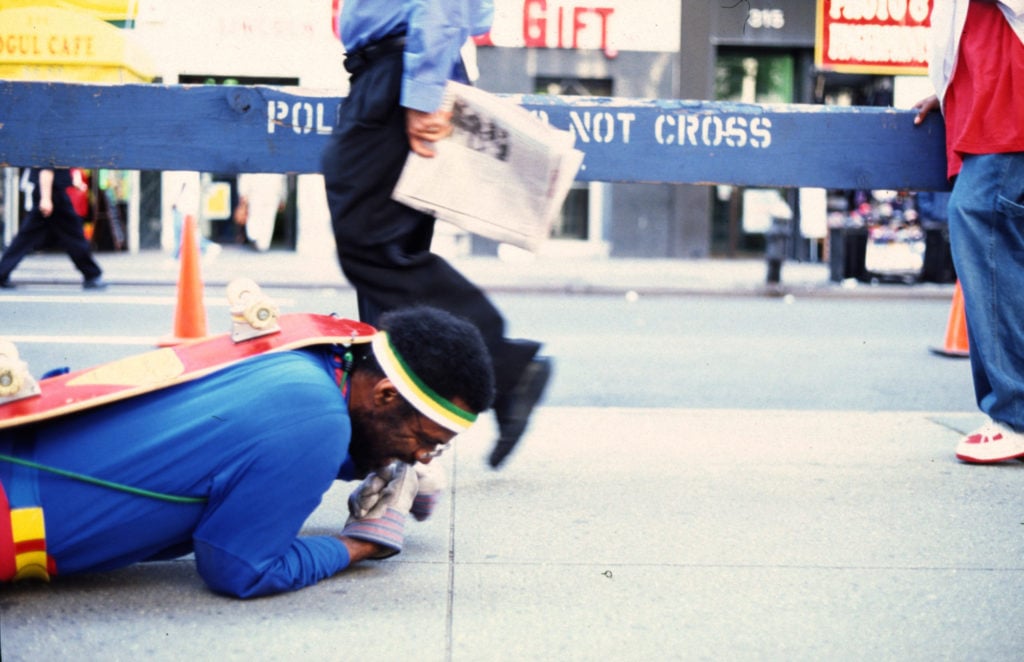
Pope.L, The Great White Way, 22 miles, 9 years, 1 street (2000–09). © Pope. L. Courtesy of the artists and Mitchell–Innes & Nash, New York.
These willing states of vulnerability have taken a toll. Pope.L has suffered from dehydration and blocked circulation, the ingestion of toxic chemicals, and the inevitable scrapes and bruises that come with dragging oneself along cement. His mother’s intervention eventually convinced him to take better care.
“Her criticism was [that] lack of care positioned the work incorrectly. I agreed,” he says. “One of the most important things I did to amend this, especially in the case of performances that involved eating, was to reduce the number of times I performed.”
At MoMA, where much of Pope.L’s work will be displayed in the form of film and photo documentation (he often worked accompanied by a camera person), the hazards of performance—the tension, the endurance, the rancid smells—will exist solely in the viewer’s imagination.
In the show’s catalogue, fellow performer Yvonne Rainer poses a pertinent question: “Why the extended duration that produces such punishment on your body when, say, a series of photos or a ten-minute video might have a comparable effect?”
“Rainer is correct that the two are comparable—but they are not the same,” Pope.L tells artnet News. “Some performances look prettier or more seductive in pictures, but an electronic capture of life has a different texture than a document of that life. Documentation is as much about what is not there as what is there. That’s what makes it interesting, frustrating, and empty. That’s why my show at MoMA, if it’s about anything, it is about holes”—a lack that viewers will revel in exploring.